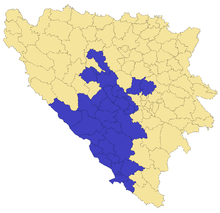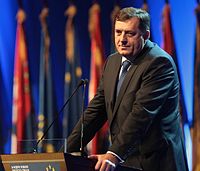Partition of Bosnia and Herzegovina
This article has multiple issues. Please help improve it or discuss these issues on the talk page. (Learn how and when to remove these template messages)
|
The partition of Bosnia and Herzegovina was discussed and attempted during the 20th century. The issue came to prominence during the Bosnian War, which also involved Bosnia and Herzegovina's largest neighbors, Croatia and Serbia. As of 2024, the country remains one state while internal political divisions of Bosnia and Herzegovina based on the 1995 Dayton Agreement remain in place.
Background

Bosnia and Herzegovina has been a single entity occupying roughly the same territory since the rise of the medieval
Although formally under Ottoman sovereignty,
Kingdom of Yugoslavia

In 1929, the oblasts were replaced with four
The Cvetković–Maček Agreement that created the Banovina of Croatia in 1939 encouraged what was essentially a partition of Bosnia between Croatia and Serbia.[1][dubious ] The agreement angered Bosniaks, then known as Yugoslav Muslims, including the Yugoslav Muslim Organization (JMO) that denounced the agreement's partition of Bosnia and Herzegovina.[2]
Yugoslav Wars
During the
The Serb and Croat political leadership agreed on a partition of Bosnia with the 1991 Milošević–Tuđman Karađorđevo meeting and the 1992 Graz agreement, resulting in the Croat forces turning against the Army of the Republic of Bosnia and Herzegovina and the Croat–Bosniak War (1992–94).[4]
In 1992, negotiations continued between Serb and Croat leaderships over the partitioning of Bosnia and Herzegovina.[5]
Franjo Tuđman argued that Bosnia-Herzegovina should form part of the federal Croatian unit because it was linked historically to Croatia.[6] Tuđman did not take a separate Bosnia seriously as shown by his comments to a television crew,[when?] saying "Bosnia was a creation of the Ottoman invasion [...] Until then it was part of Croatia, or it was a kingdom of Bosnia, but a Catholic kingdom, linked to Croatia."[7] In 1981 Tuđman stated that a federal Bosnia-Herzegovina "was more often a source of new divisions between the Serb and Croat population than their bridge".[8] Moreover, Tuđman observed that from an ethnic and linguistic viewpoint most Bosniaks were of Croatian origin.[6] He argued that a Bosniak identity could only benefit the Serbs and hence advance the timing of Bosnia's "reasonable territorial division".[8]
According to
Mario Nobilo, a senior advisor to Tuđman, is reported by Tim Judah to have informed him directly that talks took place "to resolve the Yugoslav conflict by carving up the Republic of Bosnia and Herzegovina and creating an Islamic buffer-state between them".[12]
Testimonies of other American and British politicians such as Ambassador
The Yugoslav Wars resulted in at least 97,000 deaths of citizens of Bosnia and Herzegovina,[23] and more than 1.5 million expelled.[24] A country where previously no region could be described as purely Bosniak, Serb or Croat shifted to a partitioning into multiple ethnically homogeneous nations.[24][25][verification needed]
The policies of Tuđman and Croatia towards Bosnia and Herzegovina were never completely transparent, but always included his ultimate aim of expanding Croatia's borders.[26] In the Tihomir Blaškić verdict, the Trial Chamber found that "Croatia, and more specifically former President Tuđman, was hoping to partition Bosnia and exercised such a degree of control over the Bosnian Croats and especially the HVO that it is justified to speak of overall control."[6]
Bosnian Serb involvement


Most of the Bosnian Serb wartime leadership
The Amended Consolidated Indictment, [...] alleges that, between 1 July 1991 and 30 December 1992, in order to secure control of various municipalities of Bosnia and Herzegovina which had been proclaimed part of the Serbian Republic of Bosnia and Herzegovina, the Bosnian Serb leadership, including Momčilo Krajišnik, Biljana Plavšić and Radovan Karadžić, pursued a course of conduct involving the creation of impossible conditions of life, persecution and terror tactics in order to encourage non-Serbs to leave the area, deportation of those reluctant to leave, and the liquidation of others. From late March 1992, Bosnian Serb forces seized physical control of many of the municipalities of Bosnia and Herzegovina which had been proclaimed part of the "
Serbian Republic of Bosnia and Herzegovina".
The ICTY judged as follows:[34]
The Chamber finds that a joint criminal enterprise existed throughout the territories of the Bosnian-Serb Republic. There was a centrally-based core component of the group, which included Mr Krajišnik, Radovan Karadžić, and other Bosnian-Serb leaders. The rank and file of the joint criminal enterprise was based in the regions and municipalities of the Bosnian-Serb Republic, and maintained close links with the leadership in the Bosnian-Serb capital of Pale. [...] The common objective of the joint criminal enterprise was to ethnically recompose the territories targeted by the Bosnian-Serb leadership by drastically reducing the proportion of Bosnian Muslims and Bosnian Croats through expulsion. The Chamber finds that the crimes of deportation and forced transfer were the original crimes of this common objective. Mr Krajišnik gave the go-ahead for the expulsion programme to commence during a session of the Bosnian-Serb Assembly when he called for [and I quote], "implementing what we have agreed upon, the ethnic division on the ground".
The Trial Chamber found that the strategic plan of the Bosnian Serb leadership consisted of "a plan to link Serb-populated areas in BiH together, to gain control over these areas and to create a separate Bosnian Serb state, from which most non-Serbs would be permanently removed".
Bosnian Croat involvement


On 13 October 1997, Croatian weekly Feral Tribune published a document drafted by the Bosnian HDZ in 1991 and signed by its leading members Mate Boban, Vladimir Šoljić, Božo Raić, Ivan Bender, Pero Marković, Dario Kordić and others. It stated, among other things, that "[...] the Croat people in Bosnia-Herzegovina must finally undertake a decisive and active policy that should bring about the realisation of our centuries-old dream: a common Croatian state."[35][36]
Based on the evidence of Croat attacks against Bosniaks, the ICTY Trial Chamber concluded in the Kordić and Čerkez case that by April 1993 Croat leadership had a common design or plan conceived and executed to ethnically cleanse Bosniaks from the Lašva Valley.[36] Kordić, as the local political leader, was found to be the planner and instigator of this plan. Further concluding that the Croatian Army was involved in the campaign, the ICTY defined the events as an international conflict between Bosnia and Herzegovina and Croatia.[37] Kordić along with commander Mario Čerkez were sentenced to 25 and 15 years respectively.[38]
In the Tihomir Blaškić verdict, of March 2000, the Trial Chamber concluded "[...] that Croatia, and more specifically former President Tudjman, was hoping to partition Bosnia and exercised such a degree of control over the Bosnian Croats and especially the HVO that it is justified to speak of overall control."[6]
[...] to about April 1994 and thereafter, various persons established and participated in a joint criminal enterprise to politically and militarily subjugate, permanently remove and
Croatian Banovina, a territorial entity that existed from 1939 to 1941.
The Prosecution submitted that part of the Greater Croatia-Herceg-Bosna program had at least three important goals.[40][41]
First, it was clear to probably anyone who looked at it with any sort of intellectual objectivity that some municipalities and areas claimed by Herceg-Bosna were more Croat than others and with some of the areas on the fringes more toward the east, more towards Central Bosnia not having a strong Croat majority or even plurality. [...] As a second reason, as a matter of political, military, and economic practicalities and part of the ultimate what I will call horse trading with the Serbs and the Muslims, Tudjman and the Herceg-Bosna leaders recognised that they might have to give up or trade away some of the areas furthest from the core Banovina territory. [...] Third and equally important and as already mentioned, relocating Croats from other parts of Bosnia-Herzegovina and moving them into houses and flats which had been seized from or abandoned by Muslim families or Muslim families which have been expelled would make it more difficult, if not impossible, for the Muslims to return to those areas, their houses having been taken over by Croats.
Proposed secession of Republika Srpska

Secessionist rhetoric in Bosnia and Herzegovina made a comeback after 2006, with the coming to power of the SNSD party in Republika Srpska, headed by Milorad Dodik,[44] notwithstanding international experts such as James Ker-Lindsay had defined it as a "hollow threat" and an unfeasible plan.[45]
On 25 April 2015 the ruling SNSD party adopted a declaration entitled "Republika Srpska — free and independent — future and responsibility", stating its intention to organize a referendum on the independence of the Republika Srpska in case competences are not returned from the State to the Entities by 2017. The declaration also suggests that RS authorities might decide "by law which decisions made by the Bosnia and Herzegovina authorities shall be applicable on the territory of Republika Srpska".[46]
RS president Milorad Dodik reiterated to the press the commitment to an independence referendum in the coming years if his demands are not met.[47][48] His stated political goal is to scale back the institutions of Bosnia and Herzegovina to the letter of the 1995 Dayton Peace Agreement, undoing the developments of the last twenty years including the Court of BiH and BiH Prosecutor's Office, as well as tweak such letter by getting rid of international judges sitting in the BiH Constitutional Court.[49]
Croat entity
Bosniak entity
2021 Balkan non-papers
Two documents of unknown origin appeared on various internet forums, with several sources claiming that they had been drafted by the
The first non-paper's plans and ideas were heavily criticized and reacted to by many political leaders from Bosnia and Herzegovina, Serbia, Croatia, Montenegro, Slovenia, North Macedonia, as well as by politicians from the European Union and Russia. A second non-paper, which first appeared in Kosovo's Albanian-language media in April 2021, proposed that Serbia recognize Kosovo's independence by February 2022 and that Serb-majority North Kosovo be granted autonomy in return for Serbia's recognition.
See also
- Peace plans proposed before and during the Bosnian War
- Washington Agreement
- Secession of Republika Srpska
- 2021 Balkan non-papers
References
- ISBN 9958-815-00-1
- ^ Motyl 2001, pp. 57.
- ISBN 978-1-56134-290-7.
Bosnia would be divided into three ethnically homogeneous states. The Croatian and Serbian states would be free to join Greater Croatia and Greater Serbia, respectively; the Bosnian-Muslim state would stand alone as an independent entity.
- ^ Silber, L (1997), Yugoslavia: Death of a Nation. Penguin Books, p.185
- ^ Lukic, Reneo; Lynch, Allen. 1996. Europe from the Balkans to the Urals. The Disintegration of Yugoslavia and the Soviet Union. Oxford: Oxford University Press. p. 210.
- ^ a b c d "Prosecutor v. Tihomir Blaškić - judgement" (PDF). United Nations International Criminal Tribunal for the former Yugoslavia. 2000-03-03.
- ISBN 978-0-300-09125-0.
- ^ ISBN 0-914710-70-2.
- ISBN 978-0-271-02030-3. Retrieved 2009-08-17.
- ISBN 978-0-8129-6399-1.
- ISBN 978-0-271-02030-3. Retrieved 2009-08-17.
- ^ Judah, Tim (12 July 1991). "Creation of Islamic buffer state discussed in secret". The Times.
- ^ "BH partition plans in form of a stain". Sense Tribunal. April 2, 2007. Retrieved 2009-08-17.
- ^ Kay, Sean (1998). NATO and the future of European security. Rowman & Littlefield Publishers, Inc. p. 82.
- ^ Meurs, Wim (2003). Prospects and Risks Beyond EU Enlargement: Southeastern Europe. VS Verlag. p. 168.
- ^ "Kordić & Čerkez (IT-95-14/2) | Judgement" (PDF). International Criminal Tribunal for the former Yugoslavia. 26 February 2001. p. 38. Retrieved 2022-10-16.
- ^ "WITNESS NAME: Paddy Ashdown (extract from transcript, pages 2331 – 2356)". CASE IT-02-54 PROSECUTOR vs. SLOBODAN MILOŠEVIĆ. ICTY. 14 March 2002.
- ISBN 9781841134130.
- ^ "Milosevic trial: Croatia's President Mesic gives evidence". November 2002.
- ^ a b c d Sherwell, Philip; Petric, Alina (2000-06-18). "Tudjman tapes reveal plans to divide Bosnia and hide war crimes". London: Telegraph.co.uk. Retrieved 2010-05-07.
- ^ a b c d Lashmar, Paul; Bruce, Cabell; Cookson, John (2000-11-01). "Secret recordings link dead dictator to Bosnia crimes". London: Independent News. Archived from the original on 2022-05-25. Retrieved 2010-05-07.
- ^ "Testimony of Stjepan Mesić from a transcript of the Milošević trial". United Nations International Criminal Tribunal for the former Yugoslavia. 2002-10-02. Retrieved 2009-08-17.
- ^ "JUSTICE REPORT: Bosnia's Book of the Dead". Balkan Investigative Reporting Network. 2007-06-21. Archived from the original on 2011-07-10. Retrieved 2009-08-14.
- ^ ISBN 978-0-521-67773-8.
- ISBN 978-0-521-67773-8.
- ^ "Prosecutor v. Naletilic and Martinovic - Judgement (Historical Background)" (PDF). United Nations International Criminal Tribunal for the former Yugoslavia. 2001-02-22. Retrieved 2009-08-16.
- ^ "Prosecutor v. Biljana Plavsic judgement" (PDF).
Biljana Plavsic was sentenced to 11 years' imprisonment.
- ^ "Prosecutor v. Momcilo Krajisnik judgement" (PDF).
Sentenced to 27 years' imprisonment
- ^ a b "Prosecutor v. Radoslav Brđanin - Judgement" (PDF). United Nations International Criminal Tribunal for the former Yugoslavia. 2007-04-03. Retrieved 2009-11-03.
- ^ a b "Prosecutor v. Duško Tadić - Judgement" (PDF). United Nations International Criminal Tribunal for the former Yugoslavia. 1997-07-14. Retrieved 2009-11-03.
- ^ "Prosecutor v. Ratko Mladic - Amended Indictment" (PDF). United Nations International Criminal Tribunal for the former Yugoslavia. 2002-11-08. Retrieved 2009-08-18.
- ^ "Milosevic et al. - Amended Indictment" (PDF). United Nations International Criminal Tribunal for the former Yugoslavia. 2006-03-14. Retrieved 2009-08-18.
- ^ "Report to the death of Slobodan Milošević" (PDF). United Nations International Criminal Tribunal for the former Yugoslavia. May 2006. Retrieved 2009-08-18.
- ^ "Prosecutor v. Momčilo Krajišnik - Judgement Summary" (PDF). United Nations International Criminal Tribunal for the former Yugoslavia. 2006-09-27. Retrieved 2009-11-03.
- ^ "Plans for a 'Greater Croatia' (document)". Bosnia Report. Archived from the original on 3 March 2012. Retrieved 26 May 2010.
- ^ a b "Prosecutor v. Kordić and Čerkez - Judgement" (PDF). United Nations International Criminal Tribunal for the former Yugoslavia.
- ^ "HRW: Conflict between Bosnia and Herzegovina and Croatia".
- ^ "Judgement of Trial Chamber III in the Kordić and Čerkez Case". United Nations International Criminal Tribunal for the former Yugoslavia.
- ^ "The Prosecutor v. Jadranko Prlić, Bruno Stojić, Slobodan Praljak, Milivoj Petković, Valentin Ćorić & Berislav Pušić" (PDF).
- ^ a b c "View from the Hague" (PDF).
- ^ a b c "Session from the Prlić case". 2008-02-04. Retrieved 2009-11-04.
- ISBN 978-1-59051-302-6.
- ^ Initial Indictment - Prlic et al
- ^ Adis Maksic, Referendum Discourse in Republic of Srpska Politics 2006- 2008: An Analysis of its Emergence and Performative Structure, Virginia Polytechnic Institute and State University, 2009
- ^ James Ker-Lindsay, The Hollow Threat of Secession in Bosnia and Herzegovina: Legal and Political Impediments to a Unilateral Declaration of Independence by Republika Srpska, LSEE, April 2016
- ^ 48th report to the United Nations Security Council of the High Representative for Implementation of the Peace Agreement on Bosnia and Herzegovina, 5 November 2015
- ^ "We have told everybody that we want a dialogue. If you do not want to have a dialogue with us, if you do not want to harmonize Bosnia and Herzegovina with Dayton, in 2017 our proposal will be a referendum on the status of the RS. And that status implies a free and independent Republika Srpska." Milorad Dodik, NIN magazine, 28 May 2015
- ^ "In that regard we said clearly that, unless there are visible and tangible elements of stabilization of the RS in accordance with the Constitution until 2017, meaning that many competencies that were stolen must be returned, in 2018 the RS will carry out a referendum on its status, to det ermine its status. The proposal will be an independent state." Milorad Dodik, Blic online/FENA, Istocno Sarajevo SNSD Congress, 25 April 2015.
- ^ Bosnia Today Archived 2016-09-26 at the Wayback Machine, 25 April 2015
Sources
- ISBN 0-12-227230-7. Retrieved 2013-02-03.
